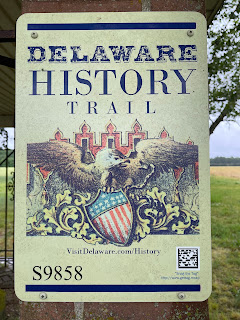Yesterday, I posted a piece about the War Memorials that are throughout Delaware. As I was doing my research, I discovered that there are other monuments that showcase just what an effect the state of Delaware has had on American History.
Here is a sample of what you can find as you begin to discover Delaware's place in the larger history of the United States.
Fort Christina, Wilmington
It is here, along the banks of the Christina River, that the first settlers from Sweden arrived in 1638. They set foot on this very spot and proceeded to establish the first permanent European settlement in this part of the world.
A year later, a man named Anthony from the West Indies settled in New Sweden. He worked as a sailor, sailing sloops up and down the river carrying goods and people as the settlement expanded. What makes this story so good is that Anthony was black and, as far as the historians can tell, was the first black man to settle in what is now Delaware. He was a free man.
Mason-Dixon Stones, Delaware/Maryland Border
In 1763, Maryland, Virginia, Pennsylvania, and Delaware were all squabbling about where the borders were for the individual states. Mr. Mason and Mr. Dixon were hired to survey the land and put the dispute to rest by establishing the borders. They did, and the borders they established still exist today.
Interestingly, Delaware's border runs north and south, so Delaware has the distinction of being east of the Mason-Dixon line.
These stones have stood since 1764 or 1765 when they were placed to show the southwest corner of Delaware and where Maryland begins.
Rodney Square, Wilmington
Listen my children and you shall hear
Of the midnight ride of.... hang on. Wrong guy.
Caesar Rodney was part of the Continental Congress in 1776. Delaware was sharply divided about independence. The northern part of the state wanted to break away; the southern part wanted to work it out with Britain. On July 1, 1776, Rodney received word that the state of Delaware was deadlocked over the issue of the Declaration of Independence.
Although he was ill, Rodney jumped on his horse and rode seventy miles through a storm to get to Philadelphia and cast the deciding vote for Delaware. Because his delegation was first, Delaware is now known as the First State.
The statue that stood on this plinth in Rodney Square since the 1930s came down this year as Rodney was a slave holder.
Cooch's Bridge, Newark
In 1777, the only battle during the Revolution to be fought in Delaware kicked off just outside of Newark. To call it a battle is a bit disingenuous; it was a lot more like a skirmish. However, it was a warm up for some of the bigger battles to come and it gave the untrained American army some actual fighting experience.
There is a legend that this battle was the first time the American Stars and Stripes flag was flown. We'll never know if that is true or not, but what a great story.
The bridge is long gone. All that remains now is a marker to show approximately where the bridge stood.
1812 Memorial Park, Lewes
In 1813, during the War of 1812, the British were attempting to block all access up the Delaware River which would have stopped all shipments into and out of the Mid-Atlantic Region, specifically Philadelphia.
A British captain tried to land his ship at Lewes as he was in desperate need of supplies. Lewes rather pointedly told him to bugger off. He began to bombard the port with his cannons; Lewes fired back from an area near where this park stands now.
After much to and fro, the British gave up and left the harbor thus enabling shipping to continue into Philadelphia.
Tubman-Garrett Park, Wilmington
Between 1849 (when she escaped for the first time) and 1860 (when she went to work for the Union Army), Harriet Tubman helped hundreds of people escape north using the underground railroad. One of the main routes ran right through Maryland's Eastern Shore (where Tubman was born) and through Delaware to Philadelphia.
Thomas Garrett lived and worked in Wilmington. He openly defied slave laws, working tirelessly with other conductors on the railroad to assist in moving slaves as far north as possible. He and Tubman worked together often as she would stop at his home on her way to Philadelphia with whomever she was with at the time.
This statue is called "Unwavering Courage in the Pursuit of Freedom." I think that sums it all up very nicely.







No comments:
Post a Comment